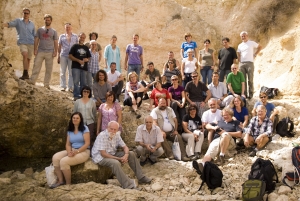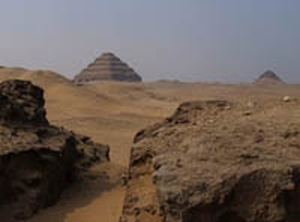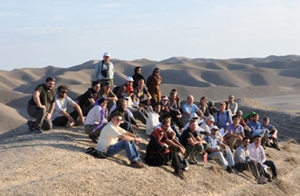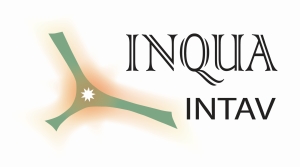SACCOM Projects & Activities
INQUA IFG 1612F Section on European Quaternary Stratigraphy (SEQS-DATESTRA)

SEQS is a group devoted to the study of the Quaternary Period in Europe, the last 2.6 million years of Earth’s history. This interdisciplinary group is concerned with the Quaternary stratigraphy of Europe. It provides a forum for Quaternary scientists to discuss and establish stratigraphical investigations and classification throughout the European continent, one of the most significant and densely investigated regions of the World. It seeks to achieve this through the organization of regular meetings, publications and publicity. In addition a network of Working Groups with a specific mandates are established under the auspices of the Subcommission.
During the 2016-2019 Intercongress period SEQS will establish a Geographic Stratigraphical Database of Terrestrial European key-sites: DATESTRA. This is a European Geographic Stratigraphical Database that will summarize the activities and the projects carried out by SEQS during the previous Intra-Congress periods when scientists from all over Europe and adjacent areas during the SEQS annual Meetings visited, observed and discussed highly detailed sedimentary records and depositional sequences in different geodynamic contexts. DATESTRA should constitute the first step to create a common base for all the Quaternary scientists who want to have a concise overview of the main stratigraphical subdivisions across the boundaries of Europe.
Leaders: Markus Fiebig (Austria); Pierluigi Pieruccini (Italy); Guzel Danukalova (Russia)
Contact: Prof Markus Fiebig ([email protected])
Website link SEQS: https://www.inqua-seqs.org/
Website link DATESTRA: https://datestra-seqs.strikingly.com/
Project 1614P : Cross checking of stratigraphic data (CROSSTRAT ADVANCED)
Project 1614P details
INQUA IFG 1709F Ponto-Caspian Stratigraphy and Geochronology (POCAS)
POCAS is devoted to the study of the geology of the Ponto-Caspian region during the Quaternary as a single geographic entity, bypassing linguistic/political/disciplinary boundaries, linking continents (Europe and Asia) more closely, and encouraging East-West dialogue and cooperation among researchers.
The Ponto-Caspian is defined here as a chain of
intercontinental basins that encompasses the Caspian, Black, Azov seas, the
Kerch Strait, the Manych Valley, and their coasts. This chain represents a
unique oceanographic system of relict Paratethys basins which were repeatedly
connected and isolated from each other during the Quaternary. This
predetermined their environmental conditions and hydrologic regimes, and
imposed specific impacts on diverse biological populations. Due to its
geographical location and semi-isolation from the open ocean, this region acts
as a paleoenvironmental amplifier and a sensitive recorder of climatic events,
in particular glacial-interglacial cycles on the Eastern European Plain and
mountains, as well as transgressive-regressive sea-level variations; thus, it
can be considered as a type region where geological history is well recorded in
a long series of marine and continental sediments to be used for the
development of the Pleistocene stratigraphy and geochronology of Central Eurasia.
Geological record of the Ponto-Caspian region history reveals the development
of global climatic changes, glacial-interglacial rhythms of the East European
plain and mountain areas of the Caucasus and Central Asia, the history of his
connection with the Oceans. The Ponto-Caspian is therefore a type region that
could provide a stratigraphic and paleogeographic scheme of the Pleistocene events
in Central Eurasia.
Leaders: Valentina Yanko-Hombach (Canada); Tamara Yanina (Russia); Redzhep Kurbanov (Turkmenistan)
Contact: Prof Valentina Yanko-Hombach ([email protected])
POCAS Website: https://avalon-institute.org/projects/
INQUA IFG 1708F Northeastern African Quaternary Stratigraphy (NAQS)

The main goal of NAQS is discussion concerning development of a formal and uniform late Pleistocene and Holocene climatostratigraphic division for the area of Northeastern Africa with special attention devoted to Egypt and Sudan.
NAQS has also been designed to highlight results of interdisciplinary geoarchaeological and paleoclimatological research by specialists from a broad field of disciplines in the humanities and geosciences made in Northeastern Africa (Egypt, Sudan, Ethiopia). The main objective of NAQS is to work towards building a platform for meaningful exchange of information and experience among archaeologists, geologists, geographers, climatologists and researchers from related fields.
Meetings, workshops and conferences in the frame of NAQS will hopefully lead to new research projects and initiatives, contributing to broaden knowledge of man’s interactions with the natural environment in North Africa during late Pleistocene and Holocene.
Leaders: Leszek Marks (Poland); Fabian Welc (Poland); Lenka Lisá (Czech Republic)
Contact: Prof Leszek Marks ([email protected])
Website link: https://geoarcheologia.uksw.edu.pl/
INQUA IFG 1707F Loess and pedostratigraphy

The Loess and Pedostratigraphy Working Group connects a
global scientific community that works collectively to better understand loess
deposits and palaeosols worldwide. This unique group brings together
researchers from a number of disciplines, including archaeology, geochemistry,
geochronology (radiocarbon and luminescence dating), geology, geomorphology,
palaeoclimate, pedology, paleoecology, stratigraphy, and tephrochronology. Due
to the preservation of loess deposits worldwide, these approaches are applied to
multiple timescales, with research into sub-orbital as well as orbital
timescales, Holocene to Early Pleistocene. Through these multidisciplinary
collaborations, the group aims to provide a better understanding of the
Quaternary.
Leaders: Zdzisław Jary (Poland), Kathryn Fitzsimmons (Germany), Qingzhen Hao
(China), Brett R. Lenz (USA)
Website link: www.loessfocusgroup.weebly.com
INQUA IFG 1710P Tephrochronology and Volcanism (INTAV)

The International Focus Group on Tephrochronology and Volcanism is a worldwide collective of geoscientists with a central interest in tephra (volcanic ash) studies and their application as a linking, dating, and synchronising tool in a wide range of disciplines including Quaternary stratigraphy, palaeoclimatology, palaeoecology, physical geography, geomorphology, pedology/palaeopedology, archaeology, geochronology, and also volcanology, including volcanic stratigraphy, volcanic petrology, and volcanic hazards and impacts. The word ‘tephra’ derives from a Greek word meaning 'ashes'. Tephrochonology refers to the use of tephras as a stratigraphic linking and dating tool but it is also used more broadly as a collective term for the study of tephras. People who study tephras and their application are referred to as tephrochronologists.
The INTAV executive and >100 members believe strongly in the importance of tephrochonologists being connected through INTAV and its activities. INTAV has been reaffirmed as an IFG through to 2019. The current core project of INTAV (2015-2019), EXTRAS (“Extending tephras”), is to enhance tephrochronology as a global research tool and its application in multiple Quaternary disciplines and volcanology. This aim is being met through seven objectives that contribute to improving the methodologies of tephrochronology and thus, through chronostratigraphy, support and underpin many Quaternary projects as well as geochronological and volcanological applications.
Leaders: Takehiko Suzuki (Japan); Britta Jensen (Canada); Peter Abbott (Switzerland/UK); Siwan Davies (UK); David Lowe (New Zealand)
Contact: Prof Takehiko Suzuki ([email protected])
Website link: https://www.comp.tmu.ac.jp/tephra/intavtmu/pg772.html
Facebook link: https://www.facebook.com/groups/INTAV/

